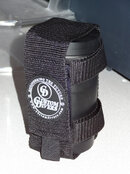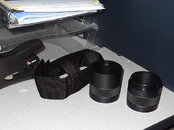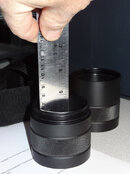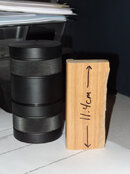Mike
Contributor
I'm putting this thread here in the Cozumel forum because this is where I got the inspiration to finally pursue something that I've been wanting for years, which is a fool proof, absolute guarantee against ever getting lost at sea when diving. The Scuba Mau boat sinking in the channel between Cozumel and the mainland in February 2012 really got me thinking what device would I have wanted with me if I was ever in that situation, I pictured my wife and myself like them floating for 5 hours in that water or even in a worse situation, totally washed out to sea, no land in sight. I started getting more motivated. The unfortunate dive accident in Cozumel of Cristina Cassin in March 2012 and her disappearance really got me thinking. I started thinking of being separated from my dive buddy who is my wife and her floating alone at sea and how helpless I would feel and how horrible I would feel if I knew that I could have done something to have given her a rescue device. Finally I got more serious and with Thanks to Ron Lee and CVChief for things they've posted and questions they've asked that helped lead me to this final solution, here it is and the odyssey I'm currently going through to make this happen.
I've known about EPIRBs for a long time which are devices that send a signal to a satellite to give your GPS location to help search and rescue find you, however the problem with them has always been that they aren't designed to go to depth, so they wouldn't work for a diver, that is if the diver wanted a device actually on his person at all times. Also EPIRBS are large in size. Looking into EPIRBs led to looking at PLBs, (Personal Locator Beacon) the little brothers to EPIRBs and much smaller. They have come a long way over the years, PLBs have grown from something a hiker might take with him to now a full blown mini EPIRB. More research lead to a specific PLB made by Ace Electronics, on July 2011 they came out with what is known as the smallest PLB on the market - the ResQLink. Shortl after they released the ResQLink+ which floats and has additional external plastic loops for strapping to a life vest or in a diver’s case a BCD. Now it seemed we were on to something. I’ve found the world’s smallest PLB, floats, waterproof... this was starting to look promising. However I soon realized, waterproof doesn't mean diveable. We still have the issue of even the ResQLink isn't able to be dived with; it's only water proof to about 16 feet. Stuck again.
Along comes Ron Lee sometime in March of 2012 and he posts a link to a company called Custom Divers and their offer of a Fast Find PLB and a 200/210 dive canister. I'm excited and back on the trail, here looks like a solution- a 'dive canister', I've never heard of it, but apparently these are water proof to depth. Unfortunately, I soon discover Custom Divers is located in the UK; I spent time on their website and could find no way of getting them to ship to the US. I emailed them asking if they could ship to the US but never got a response. A week later I get motivated to start researching dive canisters online. If there is one, I figure maybe there are many and somebody in the US surely offers them. This led me to McMurdo. Seems they make some serious at sea rescue devices and have a dive canister and you can find them matched up with the Fastfind PLB. I still want the ResQLink+; it's smaller, lighter, waterproof, it floats, and it’s less expensive than the FastFind PLB. The McMurdo canister is larger and bulkier it doesn't have any built in attachment methods like the Custom Divers 200/210 does. I’m sure the ResQLink+ is the way to go, keep it light, small and compact. I just need a smaller dive canister.
Another week goes by; I get some free time and get back on the hunt. Guess what? As of April 2012, there are exactly 2 dive canisters I can find on the market place, the McMurdo and the Custom Diver 200/210 and that is it. I'm shocked and stumped. I've got the PLB figured out, but I'm back where I started, with no way to take it diving. I spend the next week on and off researching do it yourself solutions, reading about cave divers and canisters they have made out of PVC pipe, lots of stories end with implosions at depth, lots of really bulking canisters. Seems like a dead end. About a week passes and I go on the Ace Electronics website and decide to try to contact them, maybe they have a recommendation of how to dive with their unit. I find contact information and leave a message with support telling them what I'm trying to do and ask them if they have had other people do what I'm trying to do. I leave them info about the FastFind PLB and the McMurdo canister; I even emailed them with links to it all. Unfortunately, I never hear back from Ace Electronics. Dead in the water again.
A few more days pass and I eventually go back to Custom Divers UK website to look at their canister again. I am now armed with dimensions of the ResQLink and see that darned canister over in the UK seems like it's very close in size, and sure seems like it's got possibilities of working with the ResQLink unit, however I can't figure out how to buy one. Frustrating. Finally I dig all over their website and I stumble across a small bit of wording about a US distributor. Wow, here we go! I send off an email to the email address and George Caves replies back within hours that he can sell them to me. Bingo! Next email is me sending George the how and why I want them and I give him dimensions of the ResQLink and ask him to see if he thinks it will fit in his canister. George replies back that the measurements are very close. They are so close he is worried about saying yes or no to it fitting. He does offer that if it doesn't fit, he will take the canister back if I pay for return shipping. That was good enough for me, I figure let's get a canister in hand and then figure out the rest. I mean this is half of the puzzle and I’m getting one of these!
I give George a credit card and he ships me a canister for $99.61 plus $8.20 for shipping. It shows up April 8th.
to be continued...


I've known about EPIRBs for a long time which are devices that send a signal to a satellite to give your GPS location to help search and rescue find you, however the problem with them has always been that they aren't designed to go to depth, so they wouldn't work for a diver, that is if the diver wanted a device actually on his person at all times. Also EPIRBS are large in size. Looking into EPIRBs led to looking at PLBs, (Personal Locator Beacon) the little brothers to EPIRBs and much smaller. They have come a long way over the years, PLBs have grown from something a hiker might take with him to now a full blown mini EPIRB. More research lead to a specific PLB made by Ace Electronics, on July 2011 they came out with what is known as the smallest PLB on the market - the ResQLink. Shortl after they released the ResQLink+ which floats and has additional external plastic loops for strapping to a life vest or in a diver’s case a BCD. Now it seemed we were on to something. I’ve found the world’s smallest PLB, floats, waterproof... this was starting to look promising. However I soon realized, waterproof doesn't mean diveable. We still have the issue of even the ResQLink isn't able to be dived with; it's only water proof to about 16 feet. Stuck again.
Along comes Ron Lee sometime in March of 2012 and he posts a link to a company called Custom Divers and their offer of a Fast Find PLB and a 200/210 dive canister. I'm excited and back on the trail, here looks like a solution- a 'dive canister', I've never heard of it, but apparently these are water proof to depth. Unfortunately, I soon discover Custom Divers is located in the UK; I spent time on their website and could find no way of getting them to ship to the US. I emailed them asking if they could ship to the US but never got a response. A week later I get motivated to start researching dive canisters online. If there is one, I figure maybe there are many and somebody in the US surely offers them. This led me to McMurdo. Seems they make some serious at sea rescue devices and have a dive canister and you can find them matched up with the Fastfind PLB. I still want the ResQLink+; it's smaller, lighter, waterproof, it floats, and it’s less expensive than the FastFind PLB. The McMurdo canister is larger and bulkier it doesn't have any built in attachment methods like the Custom Divers 200/210 does. I’m sure the ResQLink+ is the way to go, keep it light, small and compact. I just need a smaller dive canister.
Another week goes by; I get some free time and get back on the hunt. Guess what? As of April 2012, there are exactly 2 dive canisters I can find on the market place, the McMurdo and the Custom Diver 200/210 and that is it. I'm shocked and stumped. I've got the PLB figured out, but I'm back where I started, with no way to take it diving. I spend the next week on and off researching do it yourself solutions, reading about cave divers and canisters they have made out of PVC pipe, lots of stories end with implosions at depth, lots of really bulking canisters. Seems like a dead end. About a week passes and I go on the Ace Electronics website and decide to try to contact them, maybe they have a recommendation of how to dive with their unit. I find contact information and leave a message with support telling them what I'm trying to do and ask them if they have had other people do what I'm trying to do. I leave them info about the FastFind PLB and the McMurdo canister; I even emailed them with links to it all. Unfortunately, I never hear back from Ace Electronics. Dead in the water again.
A few more days pass and I eventually go back to Custom Divers UK website to look at their canister again. I am now armed with dimensions of the ResQLink and see that darned canister over in the UK seems like it's very close in size, and sure seems like it's got possibilities of working with the ResQLink unit, however I can't figure out how to buy one. Frustrating. Finally I dig all over their website and I stumble across a small bit of wording about a US distributor. Wow, here we go! I send off an email to the email address and George Caves replies back within hours that he can sell them to me. Bingo! Next email is me sending George the how and why I want them and I give him dimensions of the ResQLink and ask him to see if he thinks it will fit in his canister. George replies back that the measurements are very close. They are so close he is worried about saying yes or no to it fitting. He does offer that if it doesn't fit, he will take the canister back if I pay for return shipping. That was good enough for me, I figure let's get a canister in hand and then figure out the rest. I mean this is half of the puzzle and I’m getting one of these!
I give George a credit card and he ships me a canister for $99.61 plus $8.20 for shipping. It shows up April 8th.
to be continued...








